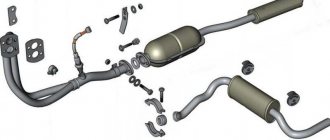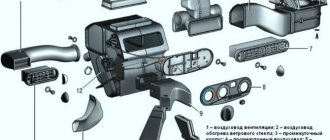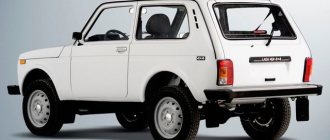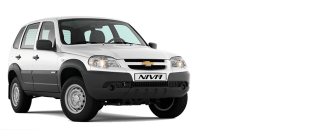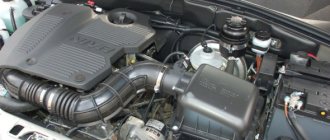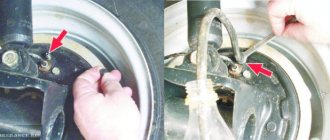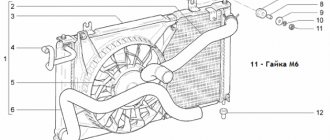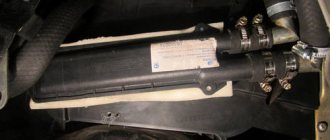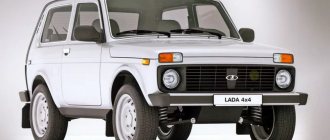At the factory, the underside of LADA cars is treated with a strong and durable anti-gravel coating. And the hidden cavities of the body are treated with anticorrosive. However, if you are going to use the car for more than 8 years, consider additional anticorrosive protection. Do you know how to properly make anti-corrosion protection for Lada 4×4 (VAZ 2121 and VAZ 2131) with your own hands?
Anti-corrosion prevention options
To carry out anticorrosive treatment, there are several options. If there is a service station in the city that has proven itself to be good, then this work can be entrusted to them. This option will be much easier than treating the Niva with anticorrosive agent yourself. Modern service stations have at their disposal all the necessary equipment and accessories that will ensure maximum effect from the procedure. And in terms of money, the treatment will be much cheaper than subsequent body repairs of a car that was not treated in a timely manner.
For those car owners who are used to doing everything themselves, a more acceptable option would be to do the bodywork yourself at home. This procedure does not take much time and money. Again, when compared with restoration work on a body that has been damaged by corrosion.
In both cases, the Niva owner needs to know the sequence of work carried out during processing. If you process it yourself, this will help you navigate the subtleties and not miss important details. If the car is handed in for service, the owner will have the opportunity to monitor the work of specialists and protect himself from poor quality service.
How to tune a Niva with your own hands
It is to this that all vibration is transmitted. There are other modifications to the Niva Chevrolet that can reduce vibrations and extraneous noise; it is best to use them. The designers strengthened the fastenings of the shelf in the luggage compartment, installed a door seal that protects the lock from dirt and snow.
The spare wheel bracket is made of thicker metal, the manufacturer promises that it will not crack. Not only the body and interior were modernized, but also the engine and suspension.
Methods for modifying the stove in a Chevrolet Niva car
The fuel injection system is now controlled by a new Bosch 7 processor. Now the power unit has become more economical, plus the low-end traction in partial load modes has improved, although the external speed characteristics of the engine have remained at the same level.
The front suspension now has a thin stabilizer, the bump stops have become smaller in size, all this gives additional centimeters of wheel travel. The spring stiffness parameters have become more stable, and the rear ones have become a little softer.
Frequency of anti-corrosion treatment
First of all, you should not think that once you coat your car with an anti-corrosion agent, you can forget about it forever. Sooner or later, this procedure will need to be repeated, since under the influence of water and other factors, the anticorrosive agent is gradually removed from the surface and the protective effect disappears.
How often to treat the car is up to the owner to decide. To assess the condition of the protective coating, you should regularly inspect the car and, if necessary, renew the anticorrosive coating. Usually, with a thorough approach to this procedure, a one-time treatment lasts for several years.
Necessary materials
In order to carry out anti-corrosion treatment of a car yourself, you need the following materials:
- Metal brush;
- Scrapers for removing used coating (wood and metal);
- Sandpaper;
- Tool for applying anticorrosion (brush or brush);
- Degreaser;
- Rust conversion agent;
- Anti-corrosion agent (mastic, etc.);
- Rags;
Related link:
TOP automobile insurance companies in Russia
Preparing the car
Before applying anticorrosive agent to Niva body parts, everything must be properly prepared. Preparation should include a thorough washing of the underbody, arches and other parts of the car. For high-quality washing, it is best to use high-pressure machines, for example, at service stations. If you work independently, then you should turn to professionals for washing.
After cleaning, the vehicle should be partially disassembled before further processing. Protective covers, if any, must be removed from the bottom. It is also advisable to remove all fender liners and mudguards; special attention should be paid to doors and sills. All excess is removed, and the interior is protected with polyethylene or paper.
Finally, it is advisable to carefully inspect the car for corrosion. If there is one, then its traces must be removed. Now there are many options for how to eliminate corrosion on a car. It is not worth treating a body damaged by rot, since corrosion will certainly spread under the anticorrosive and will bring many problems in the future.
How to properly treat from the inside
In general, the entire threshold processing process can be divided into two large categories: internal and external processing. We will discuss both problems and provide a detailed algorithm of actions. Let's start with a less obvious option - processing the threshold from the inside. This will require not only patience and professionalism, but also appropriate equipment.
- My car. Do not skip this step; it is easy to miss traces of mechanical damage on a contaminated surface.
- We remove the protective elements and internal parts of the thresholds. At the same step, it is important to wash the sills; more than a kilogram of sand can be washed out of old cars.
- Complete drying. All that remains is to wait before applying the anti-corrosion compound. You cannot rush, otherwise the work will be done in vain.
- Application of anti-corrosion compound. Here the choice is yours; we will talk in more detail about choosing a product below.
It is fashionable to write entire volumes of scientific reports about the choice of composition for processing. Conventionally, we can divide them into factory standard and amateur methods. The latter are in no way inferior to, and sometimes even superior to, expensive analogues. It is important to consider several points here. First of all, we need a viscous, viscous, but liquid composition that fits tightly to the threshold and ensures its protection for a long time. The composition must resist corrosion well and not be washed off by moisture. We will just give one example from each category.
Proven amateur remedies include candles and diesel fuel. Yes, yes, you heard right, just ordinary initialed candles. Buy about 10 - 15 large pieces and put them in a metal bucket or pan. Now we need a gas burner, you already guessed what for. Melt the candles to a liquid state, add diesel fuel and the composition is ready. Viscous paraffin adheres well to the surface. Diesel fuel prevents the mixture from quickly hardening and copes well with rust.
Professional compositions are “Movil” and “Dinitrol”. The second composition is much more expensive than Movil, but in essence they are very similar. It is difficult to determine the difference in price, but the first time you use it, the long drying process of a more budget product catches your eye.
In general, we would strongly recommend having the work done at a service center if you are not confident in the ability to properly process the car's sills from the inside on your own. If we are talking about a reliable service station, then the craftsmen know the weak points of each car and have an idea of how to properly gain access to the inside of the threshold. Sometimes a technician can give a recommendation that will not only save money, but also extend the life of your car: replace the threshold.
Working with the bottom
You can start processing with anything, this will not particularly affect the result, for example, you can process the bottom first. For treatment, any anti-corrosion agents available on the local market are used. This could be Movil or more modern auto chemical goods. It is better to consult with experienced specialists about certain products. They are familiar with all the new products and will be able to suggest the specific features of a particular product.
When processing the bottom, special attention should be paid to welds and hard-to-reach places. Corrosion often begins to act precisely there, since water and dirt are constantly retained in these areas of the body, which contribute to the rotting of the metal.
INSTRUCTIONS
The car must arrive at the anti-corrosion treatment site washed outside, underneath and in closed cavities. Dry the vehicle before applying the anti-corrosion material.
1.
Place the car on the work station (electro-hydraulic two-post lift type P-3.2G), raise the sliding windows, remove parts that prevent access to closed cavities: protective arch shields and mud-proof aprons of the front wheels, lower door seals, carpet and trunk upholstery (Phillips screwdriver, flat screwdriver, socket wrench 8, socket wrench 13, Torx wrench T20).
2.
Empty and clean the car trunk using a vacuum cleaner.
3.
Inspect the surfaces of the bottom and wheel arches from below and, if there are corroded areas of the surface, clean and treat with a rust converter according to the manufacturer's recommendations, followed by applying primary primer to the exposed metal.
4.
Drive the car into a chamber for applying anti-corrosion material and install it on a lift (lift type SL 19 (USA) f. “ROTARY”).
5.
Remove the wheels (replaceable head 17, knob).
6.
Protect wheel drives, driveshafts, shock absorber and telescopic strut rods, brake mechanisms, brake hoses and parking brake cables with covers or paper and adhesive tape.
7.
Apply anti-corrosion material (see “Codifier of main and auxiliary materials used in the maintenance and repair of LADA cars” No. K 3100.25100.00018) into the closed cavities of the car in accordance with the diagram. The material consumption rate for processing closed cavities per vehicle is 2.0 kg (a set of equipment type “ASSALUB” 1/3 (Sweden) for air spraying of the material).
The diagram shows where the anti-corrosion material is applied to the closed cavities of one side of the body; the second side of the body is treated similarly.
8.
Apply anti-corrosion material to the bottom and wheel arches (see “Codifier of main and auxiliary materials used in the maintenance and repair of LADA vehicles” No. K 3100.25100.00018) in places similar to the factory coating. The rate of material consumption per vehicle is 4.0 kg (a set of equipment type “ASSALUB” 1/26 (Sweden) for airless spraying of material). The anti-corrosion material must not come into contact with the exhaust gas system components.
9.
Remove anti-corrosion material from the outer surfaces of the car body with a cloth moistened with white spirit. Install previously removed parts onto the vehicle.
10.
The drying time of the material on the bottom and wheel arches at a temperature of 20 o C is 5 hours. During this time, it is advisable to refrain from operating the vehicle.
Treatment of hidden cavities
After treating the bottom, anti-corrosion protection should be applied to the internal cavities of the door sills. These parts also very often suffer from corrosion. To process the internal cavities of the Niva, special extensions are used, allowing you to penetrate even into places where it is impossible to see.
When treating internal cavities, care should be taken to ensure that the drainage and ventilation holes are not clogged. Some craftsmen make additional drainages using a drill. This is not worth doing, since the engineers thought out and implemented all the technical holes necessary for this.
Stage 3 – body galvanization
Anti-corrosion treatment of the Niva car was carried out by HAF galvanizing - a method of high-speed thermal spraying. Our craftsmen, using special equipment, carefully covered every centimeter of the body with 99% zinc in 2 passes. In this case, the thickness of the coating after two passes is at least 250 mKm.
By the way, if the work is carried out correctly, zinc guarantees that rust will not appear on your car over time. And everything depends on a combination of factors: the quality of galvanization of the body , whether all elements were covered with it, what thickness of the zinc layer was applied, etc. Obviously, the more thoroughly the body is galvanized, the more reliably it is protected from rust. That is why the closest attention is paid to this stage of work.
Protection of visible surfaces
After treating the internal cavities, you can apply anticorrosive to visible areas of the body. This applies to:
- engine compartment;
- spars;
- arches;
- the inside of the luggage compartment.
Care should be taken to ensure that the anti-corrosion agent does not come into contact with the rubber seals and glass parts of the car. If contact with these elements does not cause any particular harm, other than sticking of the doors and hood, then it will be extremely difficult to clean the stained glass from some products. Therefore, before processing, parts are usually protected in the same way as the interior.
APPLICATION POINTS
Scheme for applying anti-corrosion material to closed cavities of the body, bottom and wheel arches of a LADA 4×4 car:
To process the hidden cavities of the front side members, dismantle the front bumper.
Will you be doing additional anti-corrosion treatment on your Lada 4×4?
Rust converters - types and features
Rust converter is an effective chemical agent in the fight against corrosion; most often the main component of the composition is phosphoric acid. This chemical not only allows you to get rid of rust, but also protects the metal for a long time, creating a protective film. In Russia, the most widespread and popular brands of converters are:
Converters are not only liquid, but also paste-like, in the form of a gel; some products are applied by spraying; the bottles contain a spray bottle. As a rule, 15 minutes after processing the metal surface is enough for the rust to transform and be ready for further processing. After the converter has dried, the area to be treated must be cleaned with sandpaper or a metal brush, and then degreased.
Cannon fat
p, blockquote 30,0,0,0,0 –>
Separately, it is worth noting the so-called “cannon fat”. This protective composition is a thickened oil containing anti-corrosion additives, designed specifically to protect the vehicle's metal from oxidation. Solid “cannon fat”, which is used for the bottom, contains a lot of paraffin. Soft is used for processing inside cavities. This product has proven itself to be a good anticorrosive agent. It adheres well to the surface and is not washed off with water. However, “cannon fat” does not provide mechanical protection and requires periodic renewal.
p, blockquote 31,0,0,0,0 –>
